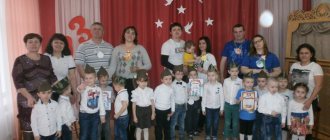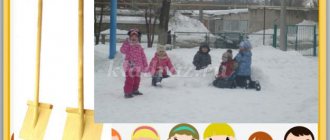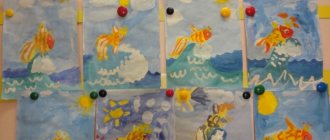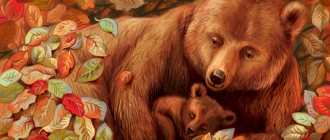Federal State Educational Standards standards
Education in the preschool period occupies an important place in the development of every child. Unified federal standards make the learning process as effective as possible.
This system allows us to consolidate the continuity of educational institutions
State standards are mandatory throughout the country. Therefore, all kindergartens must follow them. According to the Federal State Educational Standard, the teacher must take into account the individual characteristics of the child.
The social situation also matters. If the parents are dysfunctional, then work is also carried out with them. After completing the training, the preschooler must have a certain level of knowledge and be interested in the world around him.
The family is a participant in the educational process - this is enshrined in the Federal State Educational Standard.
Important! Therefore, they also must follow the teacher’s instructions and do assignments.
For example, while studying the topic “Wild Animals,” parents can make applications or read relevant articles with their child. Sometimes the teacher instructs you to prepare small material - color pictures, etc.
Current issues of patriotic education
You can fully practice at home. Therefore, parents should not be afraid of this.
Methodological literature
In preparing classes, the teacher needs to rely on certain books that contain the main points for notes. First of all, this is the book by O. A. Solomennikov “Acquaintance with nature in kindergarten.” It contains brief guidelines for planning work.
For example, it is considered how to tell children about the different seasons of the year. How is winter different, what holiday takes place during this time and what months are included in this period. All this is important so that preschoolers have a complete understanding of winter time.
Popular outdoor activities must be considered: skiing, skating, sledding, snowballs and others.
Be sure to use visual material for discussion with children
Preschoolers are guided through different groups of birds—migratory birds that stay for the winter, and domestic birds. Be sure to take into account wild and domestic animals, climate and other aspects.
Different periods of time - winter, spring, summer and autumn - are also covered in detail in kindergarten. To do this, use a nature observation diary. Tasks and lexical material can be taken from Arbekova’s workbooks.
Important! During the school year, various topics take place - space, public holidays and others. All this is needed to form ideas about the world. The more eventful the baby’s life, the better. Parents can additionally tell him about transport or other important topics.
Thematic planning. Topic of the week: “Objective world around us” (cognition)
September 19.09.2016-23.09.2016
Topic of the week : “The objective world around us
"(cognition)
Goal: formation of primary ideas about objects of the surrounding world, about the properties and relationships of objects of the surrounding world.
Tasks:
Expanding ideas about objects (subjects) of the surrounding world that facilitate human work in everyday life; their purpose.
Encouraging children to highlight the features of objects (color, size, shape, material, parts, functions, purpose).
Strengthen knowledge about glass, metal, wood; their properties.
To introduce the history of bells and bells in Rus' and other countries.
Introduce children to the history of the light bulb.
Introduce children to the history of the invention and improvement of the telephone.
Arouse interest in the past of objects. To bring to an understanding that a person invents and creates various devices to make work easier.
Forming an understanding of the need to take care of things
Strengthening skills in handling appliances and household items.
Familiarity with the basic basics of life safety when handling certain household appliances and household items.
Planned results:
- have a primary understanding of objects in the surrounding world.
- Pupils readily highlight the features of objects (color, size, shape, material, parts, functions, purpose).
- children have an idea of glass, metal, wood; their properties
Pupils learn about the history of the creation of bells and the invention of the electric light bulb and telephone.
- Pupils are oriented in the basic basics of life safety and are familiar with the necessary precautions when using household appliances and household items.
- Have some skills to use. They try to handle things that serve people with care.
Days
weeks
Priority
educational
region
Direct educational activities for children and adults
Educational activities in restricted areas, taking into account integration
educational areas
Individual direct educational activities for children
Organization of a developmental environment for children’s independent activities
Interaction with parents/social partners
Monday 09/19/2016
Cognitive
development.
Cognitive development (familiarization with the surrounding world)
Topic: “Items that make a person’s work easier in everyday life and create comfort (meat grinder, mixer, coffee grinder, kettle, vacuum cleaner, microwave oven, juicer, stove, air conditioner, fan, carpet, sconce)”
Objectives: Tell children about the importance of household items..
To form the concept that household items make our lives more comfortable and convenient
Constructive-modeling activity (artistic work): according to the plan, art. head
Morning Reception of children.
Conversation “What do I know about household appliances”
Didactic game: “Name by characteristics” (consolidating the names and functions of household appliances and household items).
Morning exercises
Walk “Watching birds.. Listening to birdsong.”
Goal: to consolidate knowledge about the diversity of birds, wintering and migratory birds.
It’s hard work to wipe the dust off the benches and tables.
Outdoor game “Blind Man's Bluff”, “Catch-Up”, “Classics”, “At the Bear in the Forest”, “Dodgeball”.
Individual work
Development of movements.
Before going to bed: work: “Cinderella”.
Gymnastics after sleep.
Conversation: “Wintering birds. How can we help them?
Game-situation: “In a household appliance store”
Independent activity. Encourage children to sing familiar songs. Design by Design
Work. Instructions for Roma and Ilyusha to tidy up the play area
Working with children experiencing difficulties in educational activities.
Board and printed game “Mosaic” to develop visual perception and fine motor skills
Add to the group material depicting various types of household appliances
Recommend walks in the forest to parents in order to consolidate knowledge about wintering and migratory birds
Tuesday 20.09.2016
Cognitive development
Educational activities with an educational psychologist. According to the plan of the educational psychologist
Cognitive development of FEMP:
“Tell me how old are you?” Strengthen counting skills within 6.
Show the formation of the number 6 based on a comparison of two groups of objects expressed by adjacent numbers 5 and 6.
Continue to develop the ability to compare up to 6 objects in length and arrange them in ascending and descending order, the results of comparison are denoted by the words shortest, longest, shorter, longer, even shorter, even longer .. (and vice versa)
Strengthen ideas about familiar three-dimensional geometric shapes and the ability to sort them into groups according to qualitative characteristics (shape, size)
Artistic and aesthetic development. Modeling. According to the plan, thin. Head
Morning Reception of children.
Conversation: “What items make life comfortable? A journey into the past of the telephone and vacuum cleaner"
Morning exercises
Walk
Work on the site: wipe the table from dust, collect dry twigs from the site.
Observation of plants. Making a proposal to the children to create their own “Little RED BOOK”. Collecting plants for her.
Outdoor games: “Dwarfs and Giants”, “Sun and Clouds”, “Rubber Bands”, “Fox in the Chicken Coop”, “Skittles”, “Dodgeball”, “Hopscotch”
Quiz: “Item-use.” Learn to establish cause-and-effect relationships between the phenomena of life around you and objects that make life easier.
Before going to bed, reading the work “Telephone” by K.I. Chukovsky
Invigorating gymnastics. "We are walking along the path." We continue to harden ourselves. Strengthening exercises on health mats
Finger gymnastics
"Finger-finger."
Conversation: “Our helpers in everyday life. Do you know what the item is for?
Game-situation: “Talking on the phone (wrong number).”
Drawing by design using a wax candle.
The work assignment of Arina Golovina and Vladik Alekseev is cleaning the play corner.
Working with children experiencing difficulties in educational activities.
Individual work: assistance in the drawing process. Learn how to work with paints correctly.
Working with a subgroup of children.
Conversation: “What is the difference between cleaning the house with a broom and a vacuum cleaner?”
Create conditions for viewing pictures of household appliances and household items
Informing parents about the progress of the educational process. Recommendations for parents of benefits for homework with children.
Wednesday 09/21/2016
Speech development
Speech development. Literacy training
(lesson using workbooks and teaching aids, task No. 4)
Topic: "Song of the Bell"
Talk about the reason why a person makes a bell from metal, and not, for example, from wood.
Continue to expand children's understanding of the history of the invention of various household items. Foster the development of interest in new knowledge. Activate nouns and adjectives in children’s speech;
Artistic and aesthetic development. Drawing: according to the art director's plan.
Physical education: according to the physical instructor’s plan
Morning Reception of children.
Conversation “What materials (metal, glass, wood, etc.) do you know. What can be made from them?
Morning exercises.
Walk: Work assignment: wipe the dust from the benches.
Observing plants in nature. To form an aesthetic attitude towards the surrounding reality. Systematize knowledge about the benefits of plants for humans and animals. Continue with the guys collecting plants for the herbarium (“Small RED BOOK”
Game “What is the name of the plant?” (consolidating knowledge about plants.
Outdoor games: “The sea is agitated once...”, “Cat and mouse”, “Leapfrog”, “Hopscotch”, “Rubber bands”, “Edible - not edible”.
Goal: to consolidate the ability to play games with rules, listen to the teacher’s commands and carry them out correctly, move randomly in a given space.
Before bed: reading: “The Faithful Stork”
Gradual rise. Invigorating gymnastics.
Solving riddles: "Grandma's riddles."
Goals: to form vocabulary; train memory, diction, reaction.
Plot-based role-playing game “The doorbell rings. Meeting guests", game-situation: "Telephone conversation"
D/I “Assemble a blanket” for Masha doll
Drawing a bell (bell tower - at the request of the children)
Evening. Reading: A. Barto “Toys”, “Truck”, “Plane”
Conversation: “Why do we need transport?”
Watering flowers. The work assignment for Artyom and Daniil is to clean up the play corner.
Working with children experiencing difficulties in educational activities.
"Drawing a Bell". To promote the development of artistic perception of the image, creative imagination. Working with a subgroup of children.
Organize an exhibition of children's drawings and works made from plasticine “Our Helpers”.
Installation of a screen for the puppet theater - “RED HIDING Hood”.
Information at the stand for parents.
We recommend that parents take a walk to the nearest Temple in order to consolidate knowledge about bells and introduce them to religious life.
Days of the week
Priority educational areas
Direct educational activities for children and adults
Educational activities in sensitive moments, taking into account the integration of educational areas
Individual direct educational activities for children
Organization of a developmental environment for children’s independent activities
Interaction with parents (social partners.)
Thursday 22.09.16
Artistic and aesthetic development
Speech development. “Eh, I’ll give it a ride. And the world of metal"
Introduce children to the history of automobile, water, air and railway transport. transport. Talk about horse-drawn transport. Introduce their differences
Goal: develop memory, logical thinking, attention;
- enrich your vocabulary, cultivate interest and love for others, broaden your horizons
Teach children to describe an object using an algorithm for describing objects (conventional symbols: belonging to the natural or man-made world, shape, color, size, heavy or light, parts, functions, material, purpose, past of the object)
Conducting classes using workbooks.
Outdoor physical education: according to the physical instructor’s plan
Artistic and aesthetic development. Music: according to the music plan. head
Morning Reception of children.
Conversation “What materials do I know (metal, wood, etc.)”
Morning exercises.
Walk
The work assignment for a walk is to wipe the benches and table from dust, to develop work skills and a sense of responsibility.
Observations of plants in the kindergarten area. Conversation about the benefits of plants. Why are plants needed in agriculture? Game: “What can you cook from this?”
Outdoor games: “Christmas trees”, “Cat and Birds”, “Catch-up”, “Hide and Seek”, “Leapfrog”, “Caterpillar” movement in a column behind the leader, repeating his movements). Playing with sand.
Reading before bed: “Little Khavroshechka”
Corrective gymnastics
Game: “What does the object tell about itself?”
Work assignments for a subgroup of children: putting things in order after games. A group of children (to instill neatness and respect for objects in the group).
Working with children experiencing difficulties in educational activities
Attention game “Cut pictures”
Goal: to develop memory, attention, perseverance.
Working with a subgroup of children
Add an encyclopedia with pictures of cars to the group. Create conditions for viewing pictures of metal objects. Distribute themed coloring books for children to work on independently
</</p>
Information at the stand for parents.
We recommend that parents tell their child about the method of metal mining. In order to consolidate the information received in class and broaden the child’s horizons
Days of the week
Priority educational areas
Direct educational activities for children and adults
Educational activities in sensitive moments, taking into account the integration of educational areas
Individual direct educational activities for children
Organization of a developmental environment for children’s independent activities
Interaction with parents (social partners.)
Friday 23.09.16
Artistic and aesthetic development
Artistic and aesthetic development. Drawing: according to the art director's plan.
Outdoor physical education: according to the physical instructor’s plan
Morning 1. Reception of children.
Conversation “How does a light bulb help us?” Journey into the past of the light bulb.
Morning exercises
Role-playing game. “The power went out...”
Walk
Outdoor games: “Paints”, “Cat and Mouse”, “Rubber Bands”, “Turnip”, “Catch, Fish”, “Oh, I’ll give it a ride!”, “Train. With stops at stations”, “Burn, burn clear!”
Work on the site at the request of the children. Goal: To teach children to independently choose their occupation
Before going to bed, read “Tales from Tears. Why do you need to turn off the lights at night?
Gradual rise, corrective gymnastics.
Riddles on the topic of lighting.. Conversation on the topic of the past week
Outdoor game “Let’s help Malvina restore order in the group.”
Consolidation of knowledge and skills in the safe operation of household appliances and household items.
Working with children experiencing difficulties in educational activities. Practice writing the numbers 1,2,3,4,5,6 (Sasha Rakhinsky, Gosha Larin, Kristina Grankina, Pasha Vorontsov, Ilya Bochkov)
Create conditions for viewing pictures depicting lighting devices of their modern predecessors.
Offer viewing of films based on the material studied
Organize an exhibition of children's drawings on the topic covered in order to develop interest in the diversity of the child's subject environment, as well as self-affirmation of children in the group




